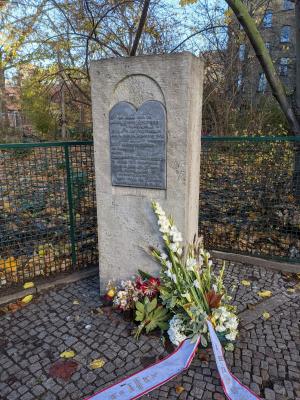Obj. ID: 42207
Memorials Memorial at the place of the synagogue in Kreuzberg, Berlin, Germany, 1958

Name of Monument
Memorial for the Fraenkelufer Synagogue in Kreuzberg, Berlin, Germany
What/Who is commemorated?
Former synagogue of Berlin- Kreuzberg
Description
A bronze commemorative panel affixed to a concrete pier is set beside the walkway along Fraenkelufer, on the boundary of the site of the former synagogue. The sidewalk widens slightly to create a small space for the monument. On one face of the concrete pier, about two thirds up, is a shallow arched indentation. Within this is a set the brone panel, in the shaped to two tablets, upon which is inscribe the brief historical narrative. A small inscribe Magen David proceeds the words of the German text. The lines of the text are unevenly spaced creating a more visually interested patter on the plaque.
Inscriptions
In German:
Hier stand eine der
Beiden grossen Kreuzberger
Synagogen.
In der Pogromnacht
vom 9. Zum 10. November 1938
brannten
Nationalsozialisten
Die Synagoge
nieder.
Das beschädigte Haupigebäude
wurde 1958 abgerissen.
Erhalten blieb die frühere
Jugend – und
Wochentagssynagoge,
Heute eines der jüdischen
Gemeindezentren in Berlin.
Translation: One of the two large Kreuzberg synagogues stood here. On the night of the pogrom from November 9th to 10th, 1938, The National Socialists burned the synagogue down. The damaged main building was torn down in 1958. The former youth and weekday synagogue, now one of the Jewish community centers in Berlin, was preserved.
Commissioned by
to be determined
sub-set tree:
Bronze
Alexander Beer designed the neoclassical synagogue in 1912 after the Jewish community acquired the site in 1911. It was dedicated on September 17, 1916. With over 2,000 seats, this synagogue was one of the largest in Berlin. The synagogue complex consisted of a main building with several auxiliary buildings on a triangular site, in which a weekday synagogue, official apartments and a building for the youth service were housed. Accordingly, it was not only intended to serve as a place of worship, but also as a community center and was used in this way in the early years.
The synagogue was set on fire on Kristallnacht, in November 1938. Because it was adjacent to a city school, the fire brigade and police kept the spread of the flames in check. The synagogue was badly damaged, but not destroyed. The ruin was eventually torn down in 1958. The former Youth synagogue was preserved and restored.
A memorial marker for the destroyed synagogue was erected on the property boundary in 1989. Designed by Cornelia Lengfeld, it reminds visitors of the destruction of the building in 1938, and fully in 1958. The surviving part of the synagogue complex (the former Youth Synagogue) is an historical monument. A historical marker on the embankment across the street shows a picture of the synagogue and also relates the story of its destruction.
Gauding, Daniela and Christine Zahn, Die Synagoge Fraenkelufer (Berlin: Hentrich & Hentrich Verlag, 2009)
“Fraenkelufer Synagogue,”
Wikipedia, https://en.wikipedia.org/wiki/Fraenkelufer_Synagogue.




